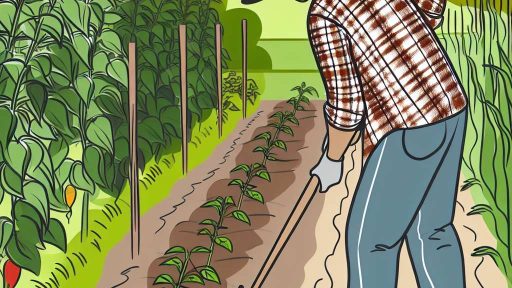Introduction to Sustainable Crop Rotation
Definition and Importance
Sustainable crop rotation involves the systematic planting of various crops in a specific order.
This method enhances soil health and boosts agricultural productivity.
It plays a crucial role in pest and weed management.
Additionally, crop rotation improves nutrient content in the soil.
Farmers can reduce reliance on chemical fertilizers through this practice.
Moreover, crop rotation can help in water conservation.
This strategy uses different root structures to promote soil aeration.
As a result, farmers can experience improved yields over time.
Crop rotation also supports beneficial microorganisms in the soil.
These microorganisms contribute to a balanced soil ecosystem.
Furthermore, rotating crops can mitigate the risks of crop disease.
Farmers can break disease cycles effectively through diverse plantings.
Consequently, they can reduce potential losses and maintain healthy crops.
Ultimately, sustainable crop rotation creates a resilient farming system.
It fosters economic benefits for small farmers who implement these strategies.
Transform Your Agribusiness
Unlock your farm's potential with expert advice tailored to your needs. Get actionable steps that drive real results.
Get StartedBy practicing rotation, farmers engage in more sustainable agricultural practices.
Benefits of Crop Rotation for Soil Health and Fertility
Improving Soil Structure
Crop rotation enhances soil structure effectively.
It helps prevent soil compaction over time.
Each crop contributes differently, improving aeration.
Deep-rooted crops break up hardpan layers.
This promotes healthier root growth for subsequent plants.
Enhancing Nutrient Availability
Diverse crops utilize nutrients differently.
This practice reduces nutrient depletion in the soil.
Legumes, for example, fix atmospheric nitrogen.
Consequently, they enrich the soil for future crops.
Such cycling supports balanced nutrient profiles.
Preventing Soil Erosion
Crop rotation significantly reduces soil erosion risks.
Distinct root systems hold soil together more effectively.
Cover crops can be integrated for added protection.
These crops shield the soil during off-seasons.
As a result, soil quality remains stable over time.
Disrupting Pest and Disease Cycles
Rotating crops helps break pest and disease cycles.
It interrupts the life cycles of harmful organisms.
Choosing different crop families reduces infestations.
Farmers notice healthier plants and reduced losses.
This ensures more productive harvests overall.
Boosting Biodiversity
Cultivating a variety of crops promotes biodiversity.
Increased biodiversity supports various beneficial insects.
Rich ecosystems enhance pollination and pest control.
Showcase Your Farming Business
Publish your professional farming services profile on our blog for a one-time fee of $200 and reach a dedicated audience of farmers and agribusiness owners.
Publish Your ProfileSuch practices contribute to sustainable farming systems.
Farmers benefit from vibrant and resilient ecosystems.
Understanding Crop Diversity
The Importance of Crop Diversity
Crop diversity plays a vital role in sustainable farming.
It enhances soil health and reduces pest outbreaks.
Diverse crops can withstand climate fluctuations better.
Benefits of Choosing Compatible Crops
Choosing compatible crops promotes mutual benefits among plants.
Some crops can naturally suppress weeds and pests.
Others enhance nutrient uptake from the soil.
Factors to Consider in Crop Selection
When selecting crops, consider soil type and climate.
Also, evaluate the market demand for specific crops.
Crop growth timing is essential to avoid competition.
Furthermore, assess the nutrient needs of each crop.
Examples of Compatible Crop Combinations
Legumes and cereals work well together in crop rotations.
- Legumes fix nitrogen, enriching the soil for cereals.
- Cereals help prevent soil erosion and offer ground cover.
Root vegetables alongside leafy greens can also be effective.
- Roots break soil compaction, aiding leafy greens’ growth.
- Leafy greens can provide shade to the soil, retaining moisture.
Implementing Crop Rotation Strategies
Crop rotation improves soil structure and fertility.
Start by mapping out a sequence of crop planting.
Rotate between families of crops to disrupt pest cycles.
Additionally, ensure that crop rotations align with seasons.
Gain More Insights: How To Incorporate Drip Irrigation For Water Conservation In Community Gardens
Seasonal Considerations: Timing Your Crop Rotation
Understanding Seasonal Cycles
Every farm thrives on the natural rhythms of the seasons.
Recognizing these cycles helps farmers plan effective crop rotations.
Seasons influence not only crop growth but also soil health.
Farmers must observe climate patterns in their regions.
Planning Your Planting Schedule
Start by determining the best planting times for your region.
Consider local weather forecasts and historical climate data.
Utilize this information to create a planting calendar.
Your calendar should outline when to sow and when to harvest.
Choosing the Right Crops
Selection of crops depends on seasonal suitability.
Rotate deep-rooted crops with shallow-rooted varieties.
This practice enhances soil nutrients while reducing pest buildup.
Legumes, for example, restore nitrogen levels in the soil.
Incorporate cover crops during off-seasons to enhance soil health.
Adjusting to Environmental Changes
Climate change impacts seasonal dynamics globally.
Farmers must adapt their strategies accordingly.
Monitor rainfall patterns and adapt planting schedules as necessary.
Flexibility is crucial for successful crop rotations.
Engaging with Local Agricultural Communities
Joining local agricultural groups can provide valuable insights.
Sharing experiences helps to discover successful rotation strategies.
Participating in workshops can improve knowledge about seasonal adaptations.
Collaboration strengthens resilience against adverse environmental changes.
Showcase Your Farming Business
Publish your professional farming services profile on our blog for a one-time fee of $200 and reach a dedicated audience of farmers and agribusiness owners.
Publish Your ProfileEvaluating and Revising Your Strategy
Regular assessment of crop rotation effectiveness is vital.
Track yields, soil health, and pest occurrences over time.
Adjust your rotation plan based on these evaluations.
Strive for continuous improvement to enhance sustainability.
Learn More: Best Organic Soil Management Practices For High-Yield Community Garden Plots
Pest and Weed Management
The Role of Crop Rotation
Crop rotation directly affects pest populations in agriculture.
Farmers can disrupt pest life cycles by alternating crops regularly.
This practice reduces the population of pests that thrive on specific plants.
Moreover, it promotes natural pest control mechanisms.
For instance, planting legumes can improve soil health and deter certain pests.
Thus, crop rotation becomes a key strategy in integrated pest management.
Diversifying Plant Species
Diverse planting interrupts habitat continuity for pests.
When farmers grow a variety of crops, pests find fewer suitable hosts.
Consequently, this reduces the likelihood of severe infestations.
Additionally, a mix of plants can attract beneficial insects.
These insects, in turn, help manage pest populations naturally.
Soil Health and Pest Resistance
Crop rotation enhances soil health, which is vital for pest control.
Healthy soil supports a diverse microbial community.
These microbes play a role in suppressing soil-borne pests and diseases.
Furthermore, plants that develop in rich soil tend to be more resilient.
Stronger plants can withstand pest attacks better than weaker ones.
Weed Management Through Rotation
Crop rotation aids in managing weed populations effectively.
Weeds often adapt to specific crops and farming practices.
This adaptability can lead to persistent weed problems.
However, changing the crop each season disrupts this pattern.
As a result, it can reduce the emergence of weed seeds.
Additionally, rotational grazing can effectively control certain weed species.
Choosing the Right Crops for Rotation
Selecting the right crops is essential for effective pest management.
Farmers should consider plant families and growth habits.
Rotating crops from different families minimizes pest transmission.
Implementing cover crops can further enhance rotation strategies.
Cover crops improve soil health and also suppress weeds.
Delve into the Subject: Small Livestock Management for Backyard Farming and Urban Homesteads
Economic Impacts
Cost-Benefit Analysis of Crop Rotation for Small Farmers
Small farmers often face financial challenges in crop production.
Understanding the economic impacts of crop rotation can inform better decisions.
Crop rotation involves alternating the types of crops grown in a field.
This practice can enhance soil fertility and reduce pest infestations.
Moreover, it often leads to higher yields over time.
Farmers should consider both short-term and long-term benefits.
Initially, crop rotation may require investment in new seeds and equipment.
Showcase Your Farming Business
Publish your professional farming services profile on our blog for a one-time fee of $200 and reach a dedicated audience of farmers and agribusiness owners.
Publish Your ProfileNevertheless, the long-term advantages can outweigh these upfront costs.
For instance, diverse crops can help improve soil health.
Healthy soil leads to better water retention and nutrient availability.
Additionally, crop rotation can reduce reliance on chemical fertilizers.
In turn, this minimizes overall operational costs for farmers.
Another economic advantage is the improved resilience to price fluctuations.
By diversifying crops, farmers can mitigate risks associated with market changes.
For example, if one crop fails, others may still provide income.
Furthermore, crop rotation can enhance access to premium markets.
Unique or organic products often command higher prices.
To perform a cost-benefit analysis, farmers should calculate potential yields.
They can compare these to the costs of implementing crop rotation.
Ultimately, informed decisions lead to sustainable agricultural practices.
Small farmers will benefit from understanding economic impacts fully.
Consequently, they can make choices that support both their livelihood and the environment.
See Related Content: The Role of Companion Planting in Organic Pest Management

Case Studies: Successful Crop Rotation Strategies from Small Farms
A Diverse Approach in Green Valley Farms
Green Valley Farms employs a six-crop rotation every year.
This strategy enhances soil fertility significantly.
Farmers grow corn, soybeans, canola, and legumes in rotation.
Additionally, they include cover crops to prevent soil erosion.
This method has improved their yield and reduced pests.
Innovative Practices at Riverbend Family Farm
Riverbend Family Farm has adopted a simple three-crop rotation model.
Their cycle includes wheat, oats, and clover.
This practice enriches the soil naturally with nitrogen.
Consequently, they have observed a marked increase in crop health.
Furthermore, this approach minimizes weed growth effectively.
Community Collaboration at Hillside Acres
Hillside Acres collaborates with neighboring farms for crop rotation.
This partnership promotes a wider variety of crops each season.
They include root vegetables, legumes, and grains in their rotation.
Moreover, this system increases biodiversity in the local ecosystem.
Farmers involved share resources and knowledge, creating community resilience.
Success Story of Maple Leaf Organic Farms
Maple Leaf Organic Farms has implemented a four-year crop rotation plan.
This plan includes corn, beans, barley, and pasture.
In turn, this method enhances soil structure and microbial diversity.
The farm has achieved organic certification, thanks to robust practices.
As a result, they have seen a substantial increase in organic market sales.
Year-Round Production at Sunny Fields Farm
Sunny Fields Farm focuses on year-round production with rotating winter crops.
They grow kale, broccoli, and carrots during the colder months.
This technique helps in maximizing land use throughout the year.
Farmers have found that winter crops also improve soil health.
Showcase Your Farming Business
Publish your professional farming services profile on our blog for a one-time fee of $200 and reach a dedicated audience of farmers and agribusiness owners.
Publish Your ProfileMoreover, this strategy attracts different beneficial insects.
Tools and Resources for Planning Efficient Crop Rotations
Crop Rotation Planning Software
Crop rotation planning software can simplify the process for farmers.
For instance, FarmLogs offers tools for tracking crop history.
Additionally, products like AgriWebb provide comprehensive farm management solutions.
These software options help farmers monitor crop performance over time.
Ultimately, this data fosters better decision-making for future plantings.
Online Resources and Databases
Numerous online resources provide valuable insights into crop rotation strategies.
The USDA’s National Agricultural Library hosts a wealth of information.
Furthermore, websites like ATTRA offer practical guides on crop rotation.
These resources are invaluable for both novice and experienced farmers.
They help farmers learn about sustainable practices and regional considerations.
Community Workshops and Field Days
Participating in community workshops can enhance farmer knowledge.
Local agricultural extension services often host events on crop rotation.
Field days provide hands-on learning opportunities.
Farmers can see successful rotations in action and ask questions directly.
This networking fosters collaboration among farmers in the community.
Consultation with Agronomists
Consulting with agronomists can significantly improve crop rotation planning.
These experts offer tailored advice based on local soil and climate conditions.
Additionally, they help identify pest management strategies aligned with rotations.
Investing in expert consultation can lead to higher yields.
Farmers benefit from personalized strategies that fit their specific needs.
Mobile Apps for Crop Management
Mobile apps have emerged as practical tools for farmers today.
Apps like Plantix assist in diagnosing plant health issues quickly.
Moreover, these apps facilitate planning and tracking crop cycles on-the-go.
Farmers can easily assess which crops are best suited for rotation.
Ultimately, mobile technology promotes efficiency and productivity in farming.
Future Trends in Sustainable Crop Rotation Practices
Incorporation of Technology
Technology is changing how farmers implement crop rotation.
Farm management software allows for better planning and analysis.
Moreover, precision agriculture can optimize planting schedules.
This ensures that crop rotation practices respond to real-time data.
Focus on Diversity
Diverse cropping systems are becoming increasingly popular.
Farmers are recognizing the benefits of mixed cropping.
This practice enhances soil health and reduces pest populations.
Additionally, integrating cover crops can improve land sustainability.
Regenerative Agriculture Practices
Regenerative agriculture is gaining traction among small farmers.
This method emphasizes restoring soil ecosystems through rotation.
Farmers are adopting practices such as agroforestry and permaculture.
These methods support biodiversity and enhance resilience.
Collaboration and Community Support
Small farmers are increasingly collaborating for better practices.
Community-supported agriculture initiatives promote shared knowledge.
Showcase Your Farming Business
Publish your professional farming services profile on our blog for a one-time fee of $200 and reach a dedicated audience of farmers and agribusiness owners.
Publish Your ProfileThis collective approach can lead to innovative crop rotation strategies.
Farmers benefit from local resources and shared expertise.
Policy and Education
Government policies are beginning to support sustainable practices.
Educational programs are essential for training farmers in new methods.
Policy changes can provide funding for sustainable agricultural initiatives.
Access to resources will encourage broader adoption of crop rotation.
Market Demand for Sustainable Products
Consumer preference for sustainable goods is increasing.
Farmers are responding to market trends by adopting eco-friendly practices.
Crop rotation enhances the quality of produce, attracting more buyers.
This trend encourages farmers to invest in sustainable methods.
Additional Resources
Understanding Crop Rotation |The Basics and Beyond | joe gardener®
Partnerships for Climate-Smart Commodities Project Summaries …




